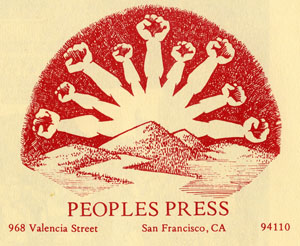Red in black and white:
The New Left printing renaissance of the
1960s – and beyond [1]
Essay by Lincoln Cushing in Peace
Press Graphics 1967-1987: Art in the Pursuit of Social Change
Catalog for 2011 exhibition at the University Art Museum,
California State University, Long Beach
Exhibition curated by Ilee Kaplan and Carol A. Wells, Center for the Study
of Political Graphics 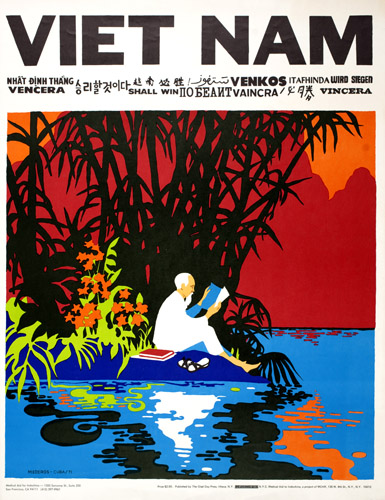
Also see: Bay Area radical printshops
"The information officers of the New American Left have rediscovered an ancient political ally: print power. All over the country, radical and "movement" organizations have spawned their own print shops run by their own pressmen to churn out an increasing number of posters, pamphlets, handbills, and flyers. Whether it's to mobilize a march on Washington, explain the advantages of "Free Speech” for GIs, or advertise courses at "Omega U. - an alternate university," the rebel presses are rolling. By the thousands, their folded-and-stapled brochures, decorated with crude graphics, are being given away at hastily set up campus tables or sold in the standard subculture outlets: Barbara's Bookshop in Chicago, the Granma in Berkeley, the Militant Labor Forum in New York, and scores of others." [2]
Every movement needs a voice, and ever since Gutenberg systematized the concept of movable type radicals have put ink to paper to create multiples of inflammatory documents. It’s also true that, as iconoclastic journalist A.J.Liebling wrote, “Freedom of the press is guaranteed only to those who own one.” [3] But at the end of the Second World War the Old Left (primarily the Communist Party, but also including other forces for change, such as the Industrial Workers of the World, or IWW) was hammered down so far by McCarthyism that political presses went into hibernation. Producing public political documents could lose you your job and your family.
The advent of relatively low-cost office spirit duplicators and mimeograph machines [4] democratized the lowest end of printing, and made it possible for unions, churches, and community groups to produce crude flyers composed on typewriters. But the trickier and larger jobs were still in the domain of professionals who had the skills and equipment. Occasionally a sympathetic shop or press operator could slip out a surreptitious tract, but for all intents and purposes public printed agitational documents like posters vanished from the landscape. It’s a remarkable fact that the Civil Rights movement and the Free Speech Movement of 1964 relied on almost every medium but posters.
What broke the ice for posters were the free handbills produced for the San Francisco rock concerts starting in 1965. All of a sudden, people realized what they didn’t know they were missing – vibrant, powerful graphics they could put on a wall. And the underground newspapers were doing crazy things with graphics. Cultural forces preceded political ones, which interestingly was happening about the same time in Cuba. The majority of posters produced by government agencies after the 1959 revolution had been relatively stiff and boring until visionary publicist Saúl Yelin at the Cuban Film Institute transformed the entire concept of a film poster. He encouraged a style where the graphic art emphasized the film’s content rather than the film’s stars, and dozens of idealistic and talented artists applied their professional skills to this new enterprise. The other Cuban propaganda agencies took note. That happened here too.
The first glimmer of the new generation of activist print shops started in 1964 in the heat of Berkeley's Free Speech Movement (FSM). Their newsletter was first printed on a 14'' x 20'' Multilith 2066 by in the basement of a home later demolished to make People’s Park. The press was owned by Dunbar Aitken, publisher of the occasional science journal Particle, but Dunbar was evicted by his landlord for printing “communist papers.” When FSM activist and Newsletter editor Barbara Garson got involved, the shop was being managed by an old Trotskyist printer named Marion Syrek. Barbara describes the scene:
Duard Hastings, a speed freak who was handy with equipment, got [the old press] running… We printed five or six issues of the FSM newsletter. The press did movement printing at cost. That was in the day of marches and demos with huge print runs of leaflets. We also took in commercial business at normal prices. But it was understood that in a political emergency the political jobs would come first.
The
shop moved several times until eventually becoming the Berkeley Free
Press, then Berkeley Graphic Arts, and is currently the site of
FSM veteran and master printmaker David Lance Goines’ St.
Hieronymous Press.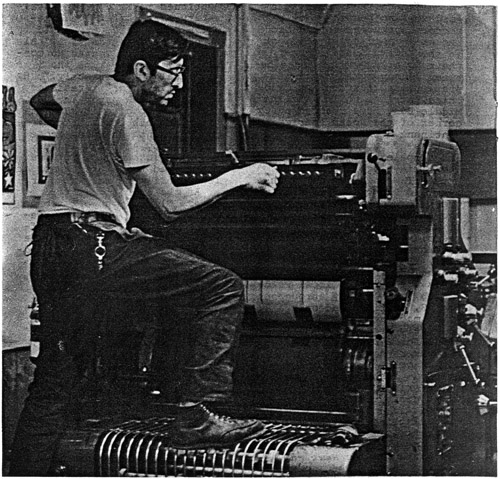
1967 saw the first generation of shops blossom. In addition to Peace Press, several other shops dedicated to social change began inking their cylinders.
Glad Day Press was founded in Ithaca, New York as a spin-off from the local peace center. The name was from William Blake’s 1795 painting, where Da Vinci’s “Vitruvian Man” is liberated from his constraining circle and square, beaming with an inner energy – an apt metaphor for the transformative feeling of the mid-1960s. They bought used equipment, learned to print, and served as a model for an independent activist shop. Although their initial priority was opposing the war in Viet Nam, they weathered shifts within the movement, including the disintegration of SDS and the end of the war in 1973, and continued to produce materials for a wide range of issues including Cuba solidarity, Native American occupations, and support for liberation movements in Southern Africa. They charged a sliding scale and produced many self-published projects, including posters and books. As they began to take on more commercial printing to sustain the shop, they relied less on volunteers and cross-trained a core group of skilled collective members, and proudly displayed the militant union label of the IWW.
Also
in 1967, in Madison, Wisconsin, local publisher Morris Edelson donated
the profits from his production of Barbara Garson's satirical play MacBird
for the purchase of a used Multilith 1250 duplicator. This became the
first movement press in the area, known variously as “Connections” or
the “DRU (Draft Resistance Union) Press.” It only lasted two years, but
served the movement well in printing numerous handbills as well as several multi-color
posters and the left magazine Radical America.[5]
well in printing numerous handbills as well as several multi-color
posters and the left magazine Radical America.[5]
Liberation
News Service (New York City), although technically not a movement shop
(rarely did they print for outside organizations) was a movement
resource that ran its material out on two little Chief 15’s. Started in
1967, LNS sent twice-weekly news packets of articles, graphics, and
photographs to member underground publications. 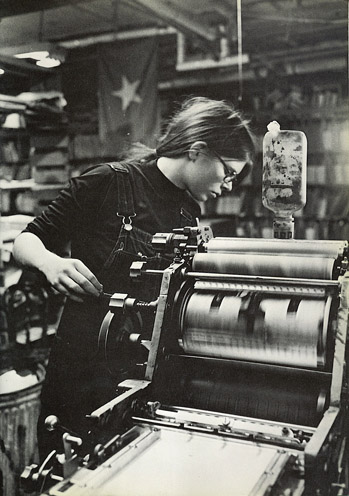
And also among the first of the “new” generation independent political print shops was Baltimore’s Liberation House Press, created by civil rights activist Walter Hall Lively (1942-1976) and subsidized by the Cummins Engine Foundation. It began around 1968 as a training ground for the young black men Walter drew to his various programs, and eventually offered a full range of printing services at cut rates to "radical groups." [6] In 1968 the New England Free Press in Boston began a 13-year run in movement job printing and publishing. They also took on that Achilles heel of all propaganda – distribution. Among their more significant titles was the feminist self-help classic Women and Their Bodies (1970), renamed Our Bodies, Ourselves in 1971, which sold 250,000 copies.
Jellyroll Press was an early San Francisco Bay Area shop, which mostly catered to the counterculture but very often that community included political work as well. In 1969 Thomas Morris was one of several people in that informal band, operating out of a funky warehouse on the Berkeley-Oakland border. This story expresses the precarious and serendipitous nature of many community print shops:
One night, just as I finished cleaning the press, the hair on my arms actually began to rise off the skin, and the air smelled electric. Opening the door into the rest of the old warehouse, I spotted flames in the back of the building. Looking into this incredible shop that we had built out of nothing, I grabbed the only possession that I cherished at the time, my leather coat, and made it to the front door on my hands and knees under the smoke, just as the fireman’s axe came crashing through the door. Word spread quickly (we had two communal houses nearby), and my friends all gathered, as we watched the building burn to the ground.
Discouraged, but not undaunted, we moved the equipment into a storefront on old Grove Street (a few doors down from the Black Panther headquarters), and began peeling back the melted rubber and rust. As the restoration work neared completion, we were approached by a women’s collective who proclaimed that they were “liberating” the machine. It was their turn to unleash the magic and power of that printing press. I believe it ended up in a building filled with poetry groups near the Ashby BART station. The small Multi 1250, remained in the storefront area at that location, where we had rooms overhead. [7]
Also in the summer of 1969 the Print Co-op started at the University of Illinois Champaign-Urbana campus. The core members would later go on to found Salsedo Press in Chicago, but the reason for starting this first shop was typical – the need for unrestricted media access. As Chris Burke remembers:
We decided to do this after the nearest printer, who was in an Air Force base town 30 miles away, began arbitrarily censoring our underground rag The Walrus (removing photos--typically naked people--and words---usually obscenities about Nixon) that he didn't agree with. I clearly remember our first self-produced issue having coverage of People's Park and the SDS convention. [8]
These
shops were followed by a whole generation of movement shops that sprang
up in almost every major city. Madison’s second shop, RPM Print Co-op,
got its start in 1970 with a grant from the Wisconsin Student
Association to buy out an existing commercial printer. Salsedo Press
incorporated in Chicago in 1973. The next year saw the triple birth of
Red Sun in the Boston area, Resistance Press in Philadelphia, and
Inkworks Press in Oakland (later Berkeley). Other shops of this vintage
include New York City’s Come!Unity Press (a 24-hour open access print
shop run by a gay anarchist collective), Fanshen in San Diego, People’s
Press in San Francisco, and Northwest Working Press in Eugene, Oregon. 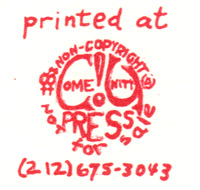
Most of these shops embraced a distinct set of qualities:
- An articulated political position;
- A sliding scale for fees and specific mechanisms for donated work;
- A commitment to hiring people not usually in the trade (women and people of color);
- Membership in a trade union;
- Organization in a non-hierarchical form, such as a collective or co-op.
Inkworks Press, an “old” shop still in operation (as are Salsedo and Red Sun), is a good example. It was formed in 1974 by several members who had been learning offset printing at an alternative school and wanted to create a movement print shop. The various streams of activism – against the Vietnam War, for international solidarity, civil rights, feminism, LGBT rights – were in full bloom, and there was a deep need for community-based media facilities. From the beginning, the shop planned to be self-sufficient, which would be accomplished with a blend of commercial and political work charged on a sliding scale. As a mechanism to institutionalize revolutionary politics, the shop became a non-profit (though not tax-exempt) corporation with a collective structure in which everyone owned it together – no one owned any individual share, as is the case with co-ops. Over the years, the collective has sought to be a model of ethnic and gender diversity, and many members came from other movement shops from around the country and Canada. In its early days the collective developed a Political Points of Unity to define where the shop stood and whom it served. Inkworks has tried to be an inclusive facility serving the broad progressive community. As a way to assure reasonable working conditions and align with the labor movement, Inkworks became a union shop (International Printing and Graphic Communications Union, now part of the Teamsters) in 1978.
After the end of the Viet Nam War, much of the wind was taken out of the sails for movement printing. But American capitalism and imperialism lumbered on, and a whole new set of movements emerged that also required printing.
One dedicated Central American solidarity print shop was New Americas Press (1981-1985), one of many such shops in the San Francisco Bay Area. Press operator Adam Kufeld remembers:
We were mobilizing for a particularly large and important demo. Kissinger was coming to town and we really want to “welcome” him. So, we decide we needed 25,000 fliers for the Bay Area. That’s a lot of fliers on two twenty-year old presses. And we decided it needed to be two colors, for impact. Well, long story short, in our stupor of printing day and night we forgot to unmask the date and time of the demo. And, well we were just going to have to run them all back though again, another 25,000 times, now that’s 75,000 impressions, in printers terms. It’s sort of funny now, but then, well it was less funny. But everyone pitched in, and we did it…[9]
The emerging women’s community also flexed its printing wings. The San Francisco-based nonprofit Women’s Skills Center set up the Women’s Press Project (WPP) in 1974 for vocational skills training in the printing trade. In addition to the important task of helping women enter a traditionally male trade, the collectively run WPP also produced paid work to support themselves. They became a union shop in 1983, and were joined by sister shop Up Press the next year. They eventually closed down due to the departure of several key members, coupled with the challenge of serving as a training facility also producing commercial work.
The unique challenges for women entering this traditionally male trade were huge, but the rewards were worth it. Here is one contemporaneous assessment of the situation by Jean Engle, co-owner of Ink Well Press in Youngstown, Ohio:
Who are the lesbian and feminist printers? We range in our politics from lesbian-separatist to commercial job shops. We are organized as collectives, cooperatives, partnerships, and proprietorships. Some lesbian and feminist printers work in relatively large collectively owned shops such as Iowa City Women's Press; others of us run small enterprises singly or with other feminists. Some are part of "movement" press collectives that specialize in printing for liberation and social movements. And a great number of lesbian and feminist printers struggle to maintain their politics in the varying climates of male-owned commercial shops. We are not only press operators - we are engaged in all aspects of print and "print prep" from typesetting and layout, to camera and stripping [10] , to binding.
Like all other lesbians and feminists, our work comes into conflict with patriarchal, consumer values. For example, feminist-owned shops are usually working with "outdated" equipment that slows our production and restricts the range of what we can produce. Why don't we do as the male-owned shops do - borrow money and purchase new, better equipment? There are several reasons. First in importance is that most of us have chosen, by the very act of being lesbians and/or feminists, to seek alternatives to the capitalist, patriarchal business institution. We are looking to focus more of our energy on the process of production, not the product itself. That means taking time to discuss, work out hassles, reach consensus: it means trying to integrate our "work" lives with our "personal/political" lives. If we refuse to let money and production run our lives, we are going to be very wary of tying ourselves to enormous debt (and printing equipment is expensive). It is a choice about values.[11]
The future of movement shops
From the 1980s on, new shops continued to appear with decreasing frequency. Some carved out a niche, such as letterpress work or Latin American poetry books, but the trade was fundamentally changing. Personal computers and “desktop publishing” replaced skilled typographers; inexpensive flatbed scanners and Photoshop now accomplish in seconds what used to take hours and cost a fortune. Printing on paper itself is an endangered craft, although it’s far from dead. Scale matters. The Web can’t compete with a simple flyer to get local citizens fired up about a neighborhood struggle. Tangibility matters. People will still pay something for a nice booklet or poster to take home and keep. New to the trade is Lantz Arroyo, pulling together the brand-new (2010) Radix Media print shop in Portland, Oregon. He describes his rationale:
Learning to print on an offset press has been really empowering. It’s really old technology. When I load a plate onto the press and start running it, I’m doing the same thing as someone a hundred years ago was doing. There are differences, sure, but the technique is the same, and that’s really exciting to me. My main goal with Radix, from the very beginning, has been to make beautiful propaganda. I consider it a form of activism, but it’s a factor that many times gets overlooked. Humans are very visual; if something doesn’t look good, people just aren’t going to pick it up, and they’re definitely not going to digest whatever message you’re trying to send. [12]
Yes, as sister Engle put it, it’s all about values. The primary reason anyone engaged in the craziness of running a community print shop was to serve the people. Peace Press, and all the others who chose that humble path did so for the most noble of reasons – to support an informed and active citizenry. Long live the free press.
Lincoln Cushing
ran his first Multilith 1250 in 1971; he later co-founded the
University of California San Diego Print Collective (1974-1978) where
he ran an AB Dick 360. He was a member of the Inkworks Press collective
for 19 years and is currently an archivist and author. See his book All
Of Us Or None: Social Justice Posters of the San Francisco Bay Area,
about the political poster renaissance of the 1960s and 1970s. You can
see more at www.docspopuli.org
Special
thanks to Carol Wells, Ilee Kaplan, and the staff at the CSULB Art
Museum for producing this important exhibition and catalog. This essay
first posted 9/16/2011, revised 10/1/2011.
For a British essay on a similar theme, see "Free Radicals"
by Jess Baines.
Directory
of San Francisco Bay Area political and countercultural screenprint and
offset shops.
Photos
1. “Viet Nam Shall Win," artwork by Rene
Mederos (Cuba), poster published by Glad Day Press for N.Y.C.
Medical Aid to Indochina, 1972.
2. “Glad Day’s biggest press, a Chief 126.” Photo from “Left Profile:
Glad Day Press” in Liberation Support Movement News, Winter
1978.
3. Liberation House logo, from International
Women's Day poster circa 1969.
4. Kathy Mulvihill operating Liberation News Service press, photograph
by Anne Dockery, 1970.
5. Come!Unity Press logo
6. Peoples Press logo
Endnotes
1. This essay only begins to capture the rich and neglected story of radical presses in America. This research is a work in progress, and space here only allows a limited treatment of the subject. A phrase in the 1975 booklet Sing a Battle Song: Poems by Women in the Weather Underground Organization expresses the challenge of compiling this sort of history:
“One thing I know
all truths come close, are never
the final verity…”
Any corrections, amplifications, criticisms, or suggestions are welcome by the author.
2. “Young Radicals Rediscover and Use the Power of the Press,” by Lynn Sherr, Associated Press; This version from the Spartanburg (South Carolina) Herald-Journal, July 8, 1970.
3. Liebling, Abbott Joseph. 1961. The press. New York: Ballantine Books, 30.
4. For
more on this technology, see “Cranking It Out, Old-School Style: Art of
the Gestetner," by Lincoln Cushing
NEW RESOURCE
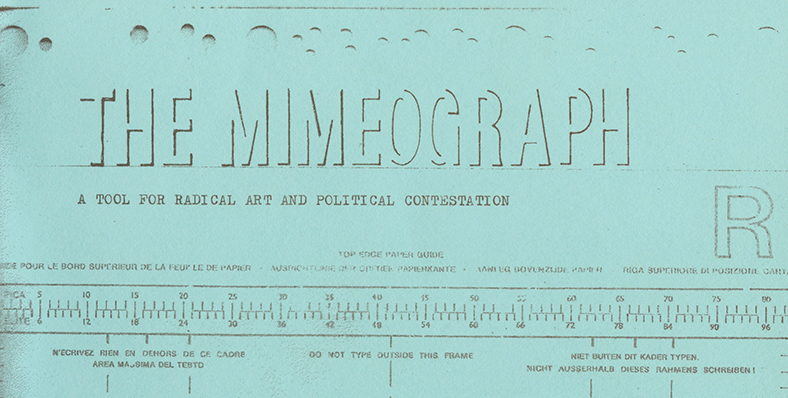
The Mimeograph: A Tool for
Radical Art and Political Contestation
Booklet
compiled by Alt Gar Bra, Bergen, Norway, 2016. A wonderful compilation
of essays and articles from all over the world about the use of
mimeograph and Gestetner machines for political propaganda - and
produced in a limited edition on a Gestetner!
5. “Largest U.S. Collector Takes You to Madison: Poster Country” The Bugle American, Vol. 7, No. 15 April 23, 1976, by J. Wesley Miller.
6. “Walter Hall Lively (1942-1976) Civil Rights Activist & Black Liberationist,” by Rudolph Lewis, ChickenBones: A Journal for Literary & Artistic African-American Themes
7. Author interview with Thomas Morris, 12/8/2009
8. e-mail correspondence with Chris Burke 1/12/2011.
9. Adam
Kufeld, "http://cispes30years.org/1980/10/founding-of-cispes" [no longer posted]
10. Several of these skills no longer exist in the current digital world – typesetting was the preparation of raw text into printable format, cameras were used to shoot that physical artwork, and stripping was the assembly of that film in a way that plates could be burned.
11. “Why Feminist Printers?” by Jean Engle, in Feminist Collections, published by the Women’s Studies Library Resources in Wisconsin, Vol. 4 No. 3, Spring 1983.
12. Interview in the veganism and animal rights weblog No Fucking Whey! 11/4/2010; <http://nofuckingwhey.blogspot.com/>
Last updated 9/25/2025
